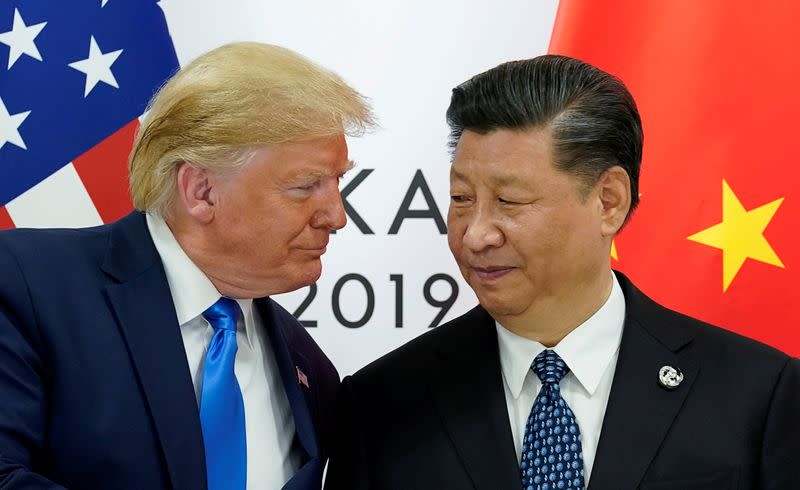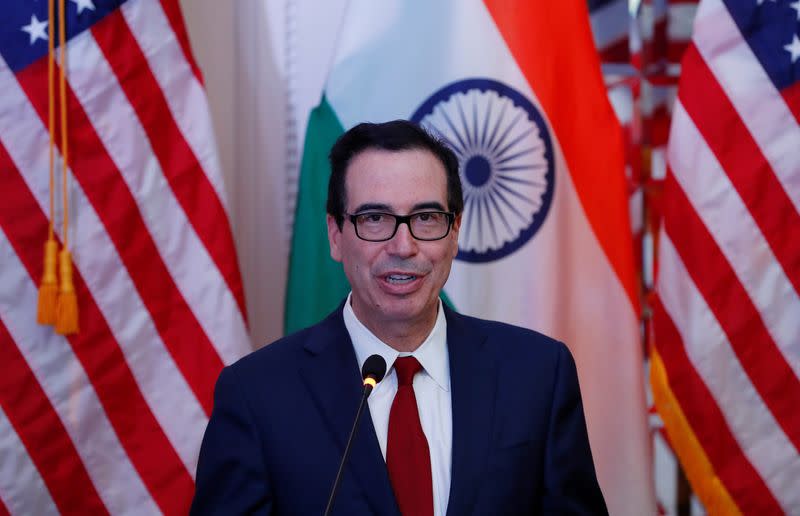Trump upbeat on U.S.-China talks as Beijing underscores tariff-cut demands
By Jeff Mason and Yawen Chen
WASHINGTON/BEIJING (Reuters) - U.S.-China trade talks are "moving right along," President Donald Trump said on Thursday, striking an upbeat tone even as Chinese officials held fast to their line that existing tariffs must come off as part of an interim deal to de-escalate the 17-month trade war between the two powers.
"It's moving along very well," Trump told reporters when asked about the talks, a refrain of comments made on Wednesday. Earlier in the week, though, Trump rattled global markets when he said a deal might have to wait until after the 2020 election.
His remarks came after Chinese officials reiterated their stance that some U.S. tariffs must be rolled back for a phase one deal.
"The Chinese side believes that if the two sides reach a phase one deal, tariffs should be lowered accordingly," Chinese commerce ministry spokesman Gao Feng told reporters, adding that both sides were maintaining close communication.
U.S. Treasury Secretary Steven Mnuchin said deputy negotiators held a call in the last 24 hours and are "actively working" toward a deal. He said talks are on track but the United States is not bound by an "artificial" deadline.
Completion of a phase one deal between the world's two biggest economies had been initially expected in November, ahead of a new round of U.S. tariffs set to kick in on Dec. 15, covering about $156 billion of Chinese imports.
Asked whether he will allow those tariffs to take effect, Trump said: "We'll have to see, but right now we're moving along. We're not discussing that, but we are having very major discussions. On December 15th, something could happen but we are not discussing that yet. We are having very good discussions with China, however."
Trump's and Mnuchin's comments did little to soothe Wall Street, where stocks were little changed as market participants stayed on the sidelines, awaiting further developments in the trade talks. All three major indices were slightly higher in late trading.
CORE ISSUES
Trade delegations on both sides remained locked in discussions over "core issues of concern," with rising bilateral tensions over non-trade issues such as the protests in Hong Kong and Beijing's treatment of its Uighur Muslim minority clouding prospects for a near-term deal to end a trade war.
China warned on Wednesday that U.S. legislation calling for a tougher response to Beijing's treatment of Uighurs in the western Chinese region of Xinjiang will affect bilateral cooperation.
But "there is no need to panic," as the trade talks did not stop, a Chinese source who advises Beijing on the negotiations told Reuters on Wednesday.
"Both leaders have talked about reaching a deal, and officials are now finishing the work," said the source, who thought it unlikely China would retaliate against U.S. legislation by releasing its so-called "unreliable entities list" aimed at punishing firms deemed harmful to Chinese interests.
When asked if China would release the list this year, Gao said he had no further information to reveal at present.
Beijing may hold back from publishing the list until the trade situation with the United States is at its most tense, a Chinese government source told Reuters in October.
On Nov. 7, Gao said China and the United States must simultaneously cancel some existing tariffs on each other's goods for both sides to reach a phase one trade deal, but there was room for negotiation.
On a telephone call last week, China's lead trade negotiator Vice Premier Liu He discussed "core issues of concern" with U.S. Trade Representative Robert Lighthizer and Mnuchin.
Washington imposed additional 15% tariffs on about $125 billion worth of Chinese goods on Sept. 1, on top of the 25% tariffs levied on an earlier $250 billion list of industrial and consumer goods.
Trump and Lighthizer recognize that rolling back tariffs for a pact that fails to tackle core intellectual property and technology transfer issues will not be seen as a good deal for the United States, a person briefed on the matter told Reuters last month.
Trump has made whittling down the U.S. trade deficit with China a top priority of his presidency, and data from the Census Bureau on Thursday showed the goods deficit narrowed in October for a third straight month to $31.3 billion, with imports unchanged and exports increasing 3.4%. So far this year, the cumulative deficit has declined by nearly 15%, to $294.5 billion from $344.8 billion in the first 10 months of 2018. [L1N28E1GJ]
Still, Chinese purchases of American soybeans, a key U.S. export, slid to a six-week low late last month, the Agriculture Department reported.
(Reporting by Gabriel Crossley and Yawen Chen; Additional reporting by Lucia Mutikani and David Lawder in Washington and Mark Weinraub in Chicago; Writing by Ryan Woo and Dan Burns; Editing by Clarence Fernandez, Jacqueline Wong and Dan Grebler)

